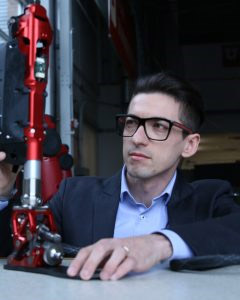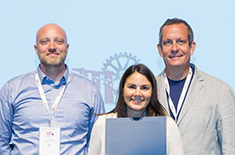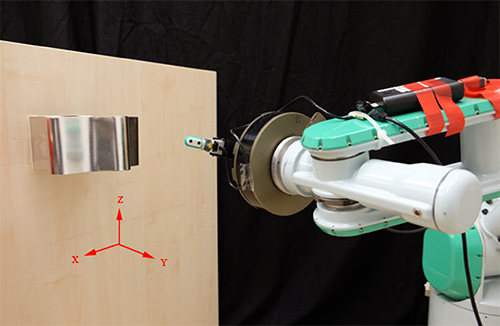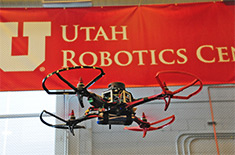Prof. Jake Abbott’s work on magnetic capsule endoscope featured in an article in PCMag.com: https://www.pcmag.com/news/363730/this-robot-might-make-invasive-colonoscopies-a-thing-of-the ...
Read MoreProf. Lenzi receives $972K DoD CDMRP grant for motorized hip orthoses
Congratulations to Prof. Tommaso Lenzi for receiving new $972K DoD CDMRP grant entitled, “Motorized Hip Orthoses to Improve the Gait Ability of Transfemoral Amputees”. The goal of the project is to validate a new approach to improving amputees’ mobility—providing bilateral hip assistance with a motorized orthosis. Hip orthoses are very lightweight, and their mass is located close to the body center of mass, thus minimizing the metabolic energy cost of carrying this additional weight. In addition, as the orthosis is not suspended through the socket interface, it does not affect balance or socket stability. Because motorized hip orthoses can be...
Read MorePopek, Hermans, and Abbott Win Best Paper Award in Medical Robotics at ICRA 2017
Katie Popek, Tucker Hermans, and Jake Abbott’s paper entitled, “First Demonstration of Simultaneous Localization and Propulsion of a Magnetic Capsule in a Lumen Using a Single Rotating Magnet,” was recently awarded the Best Paper Award in Medical Robotics at the 2017 IEEE International Conference on Robotics and Automation (ICRA) in Singapore. ICRA is the largest annual international robotics conference, and is the flagship conference of the IEEE Robotics and Automation Society. Abbott is an associate professor in the Department of Mechanical Engineering, Hermans is an assistant professor in the School of Computing, and Popek recently earned her Ph.D. in Computing (Robotics Track) while conducting research...
Read MoreResearch paper by robotics student Sundaralingam and Prof. Herman on manipulation accepted for publication in Robotics: Science and Systems (RSS)
Balakumar Sundaralingam’s and Tucker Hermans’ research paper entitled, “Relaxed-Rigidity Constraints: In-Grasp Manipulation using Purely Kinematic Trajectory Optimization” was recently accepted in Robotics: Science and Systems (RSS), 2017. Congratulations!...
Read MoreProf. Jake Abbott receives new $385k NIH grant for telerobotic eye surgery
Project title: Quantifying the Benefits of Head-mounting in Telemanipulated Robotic Eye Therapies Many of the up-and-coming therapeutic protocols in ophthalmology are technically difficult, near or beyond the limits of human ability, and are being attempted by only a few surgeons. Surgeon hand tremor combined with patient movement due to breathing and snoring place a lower limit on achievable precision. Over the past few years, with the support of Intuitive Surgical, Abbott and his collaborators have developed a robotic manipulator that is more precise than all prior systems designed for robot-assisted eye surgery, and which is small and light enough...
Read MoreAccepted 2017 ICRA papers by Utah Robotics Faculty and Students
The following papers by Utah Robotics faculty and students were recently accepted to the 2017 ICRA: P. Sabetian and J. Hollerbach, “A 3 Wire Body Weight Support System for a Large Treadmill”, IEEE Int. Conf. Robotics and Automation, 2017, to appear. J. J. Abbott, J. B. Brink, and B. Osting, “Computing Minimum-power Dipole Solutions for Interdipole Forces using Nonlinear Constrained Optimization with Application to Electromagnetic Formation Flight, IEEE Robotics and Automation Letters, accepted. K. M. Popek, T. Hermans, and J. J. Abbott, “First Demonstration of Simultaneous Localization and Propulsion of a Magnetic Capsule in a Lumen using a Single Rotating...
Read MoreProf. Mark Minor receives new $1.75M NSF grant for smart helmets
Project title: Reducing Traumatic Brain Injury Risk with Smart Collision Detection and Mitigation The goal of the project is to reduce the risk of Traumatic Brain Injury (TBI) through smart technology that collects sensory data to predict and characterize impacts in real-time, optimizes protective mechanisms based on impact characteristics (e.g., direction, velocity), and transmits final impact attributes to a database for further analysis and injury risk prediction. This technology will substantially improve TBI prevention and diagnosis in motor vehicle crashes, sports, and industrial accidents. The unique technology will leverage musculoskeletal and biomechanical computational models linking head linear and angular...
Read MoreJake Abbott’s group publishes in IEEE Transactions on Human-Machine Systems and IEEE Robotics and Automation Letters
Jake Abbott’s group publishes two new research papers, one on how humans interact with robots designed for precision tasks such as microsurgery and another on localizing magnetic capsule endoscopes inside the human body. In their new paper “Human Velocity Control of Admittance-Type Robotic Devices With Scaled Visual Feedback of Device Motion,” published in the IEEE Transactions on Human-Machine Systems, Dr. Abbott’s group describes the control of a class of robots uses for very precise tasks. These robots are heavily geared, so that they only move in a very controlled way, and the human operator interacts directly with a force sensor...
Read MoreProf. Tucker Herman’s and colleagues’ IROS 2016 paper accepted
Prof. Tucker Hermans paper entitled, “Active Tactile Object Exploration with Gaussian Processes”, was recently accepted to the 2016 IEEE/RSJ International Conference on Intelligent Robots and Systems (IROS). His co-authors are Zhengkun Yi, Roberto Calandra, Filipe Veiga, Herke van Hoof, Yilei Zhang, and Jan Peters. ABSTRACTAccurate object shape knowledge provides important information for performing stable grasping and dexterous manipulation. When modeling an object using tactile sensors, touching the object surface at a fixed grid of points can be prohibitively time consuming. In this paper, we present an active touch strategy to efficiently reduce the surface geometry uncertainty by leveraging a probabilistic representation of object surface. In particular,...
Read MoreLeang, Pardyjak, & Nevada NanoTech Receive US Army DOD Grant to Develop Chemical Sensing Aerial Robot
Kam Leang and Eric Pardyjak partnering with company Nevada NanoTech Systems, Inc., receive US Army DOD grant to develop a chemical sensing aerial robot. The two-year $1,000,000 (Utah’s share of $330,000) project, entitled, “STTR Phase II: Autonomous Broad Spectrum Environmental Sentinels“, will focus on developing an autonomous, hover-capable, flying robot with integrated real-time chemical sensing, inter-unit communication and basics swarming capabilities, and the potential for self-powering. The final platform will detect and identify airborne chemicals using an onboard Molecular Property Spectrometer (MPS)—a low-cost, MEMS-based, lab-on-a-chip platform developed with support from DARPA and the DOD. This chip provides multi-mode chemical analysis with...
Read More






